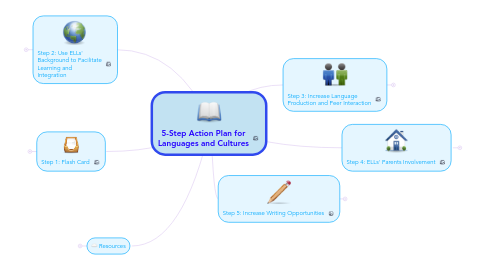
1. Step 2: Use ELLs' Background to Facilitate Learning and Integration
1.1. Pair two students or more in one group where each student has to explain his/her culture
1.2. Who -
1.2.1. Teachers
1.2.2. All students
1.3. What -
1.3.1. Group activities to emphasize cultures and make a presentation in the classroom
1.4. Where -
1.4.1. In the classroom
1.5. When -
1.5.1. Before holidays
1.5.2. Weekly basis
1.6. Why -
1.6.1. Teachers can work creatively to elicit background knowledge from students on content topics in order to increase understanding of the material.
1.6.2. ELLs will feel comfortable explaining their culture to their classmates.
1.6.3. Students will relate to each other through their experiences. Examples: soccer, basketball and food.
1.7. How -
1.7.1. Students can use charts, graphics or videos
1.7.2. Written reports explain the what I know, what to know and what was learned from other students.
1.7.3. Example
2. Step 1: Flash Card
2.1. Flash cards for students when teaching English (reading and writting)
2.2. Who -
2.2.1. Teacher
2.2.2. Assistant teacher
2.2.3. ELLs
2.3. What -
2.3.1. Flash cards consisting of letters of the alphabet, with letters on the front and a set of words on the back. The idea is to practice the letters' sound.
2.4. Where -
2.4.1. In the classroom, during reading activities
2.5. When -
2.5.1. At least twice a week
2.5.2. After hours (if available)
2.6. Why -
2.6.1. To let the students listen to the letter's sound and visualize them using examples.
2.7. How -
2.7.1. Teacher read the sound loudly and students repeat after his or her, then the teacher turn the card to read some words and show a picture if available. Example: C sound /K/ with a video to illustrate the sound and the image of C
3. Resources
3.1. http://www.colorincolorado.org/article/five-things-teachers-can-do-improve-learning-ells-new-year
3.2. http://www.enotes.com/research-starters/cultural-values-their-impact-education
3.3. http://www.tolerance.org/supplement/culture-classroom
4. Step 4: ELLs' Parents Involvement
4.1. Increase parent involvement and make them more comfortable coming to the classroom even if they don't speak English
4.2. Who -
4.2.1. Parents
4.2.2. Teachers
4.2.3. Students
4.3. What -
4.3.1. Parent involvement will help students to improve, develop and progress at school
4.4. Where
4.4.1. School
4.4.2. In the classroom
4.5. When
4.5.1. Monthly basis
4.6. Why
4.6.1. ELLs' parents will be very pleased and excited to hear positive news about their children and will feel more comfortable asking questions and visiting the school in the future.
4.6.2. Teacher can invite family members to show each student's work. This will make the student proud and it will encourage him/her to do better.
4.7. How -
4.7.1. Provide the parents with the information they need about their children's progress.
4.7.2. Encourage parents to expose their kids to English at the grocery store, mall, library...
4.7.3. Example
5. Step 3: Increase Language Production and Peer Interaction
5.1. Increase students' English production and peer interaction
5.2. Who -
5.2.1. Teacher
5.2.2. ELLs
5.2.3. English speaking students
5.3. What -
5.3.1. Group activity where the teacher asks a question and gives two minutes to think about the answer. A pair of students, including one ELL student, forms an answer and says it loudly in the class.
5.4. Where -
5.4.1. In the classroom
5.5. When -
5.5.1. During reading time, group activity
5.6. Why -
5.6.1. Teachers can informally assess for correct use of language structures and academic vocabulary. The teacher will be able to offer students guidance and further instruction to support language development. This project will help students become better critical thinkers.
5.7. How -
5.7.1. It can be used for lower level grades as well as middle school grades' students
6. Step 5: Increase Writing Opportunities
6.1. Students will engage in a writing activity that focuses on a certain skill such as creative vocabulary use
6.2. Who -
6.2.1. Students
6.2.2. Teacher
6.3. What -
6.4. Where -
6.4.1. In the classroom
6.4.2. At home
6.5. When -
6.5.1. On a daily basis
6.6. Why -
6.6.1. ELLs will develop their writing skills by studying word usage, in addition to the mechanics of writing.
6.7. How -
6.7.1. Start the project with verbal work, then ask the student to finish it by writing his/her ideas.
6.7.2. As students develop language skills, they often develop listening skills first, followed by speaking skills (they begin to formulate their ideas in the second language), then reading skills (they can understand the sound/symbol correspondence of the new language and make sense of the words) and finally writing skills (they have enough language to express their own ideas in writing).
6.7.3. Tips for preparing kids to write
